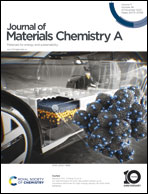An ultramicroporous multi-walled metal–organic framework for efficient C2H2/CO2 separation under humid conditions†
Abstract
The removal of carbon dioxide (CO2) from acetylene (C2H2) is not only industrially important for acetylene purification but also scientifically challenging owing to their high similarities in physical properties and molecular sizes. Multi-walled and ultramicroporous metal–organic frameworks (MOFs) can provide multiple specific interactions with C2H2 supplied to form a cooperative effect for efficient separation properties. Herein, we report a new strategy involving the extension of vertices to create an infinite multi-walled MOF (In-TATB) from 2,4,6-tris(4-carboxyphenyl)-1,3,5-triazine (H3TATB) and In(III) ions. Two 3D frameworks built from In(III) chains and TATB3− molecules interpenetrate through strong π–π interactions between triazine rings. Taking advantage of the confined ultramicroporous space (3.8 Å × 4.1 Å) and accessible sites of multiple walls, In-TATB shows a high adsorption enthalpy of C2H2 (36.6 kJ mol−1 at 298 K and low-coverage) and excellent separation of C2H2/CO2 mixtures with an IAST selectivity of 11.8 (at 298 K and 1 bar). More importantly, both dry and wet breakthrough results validated its exceptional separation performance for C2H2/CO2 mixtures, affording a high dynamic separation factor. This work provides a novel and powerful approach to address this extremely challenging gas separation in industry.



 Please wait while we load your content...
Please wait while we load your content...